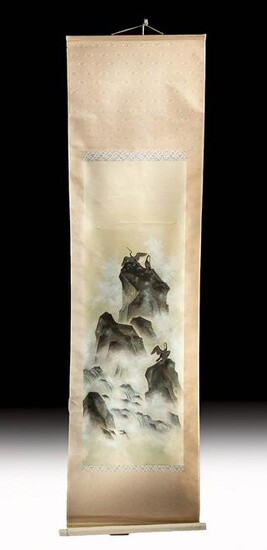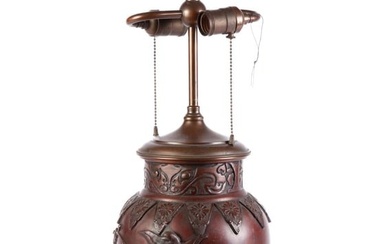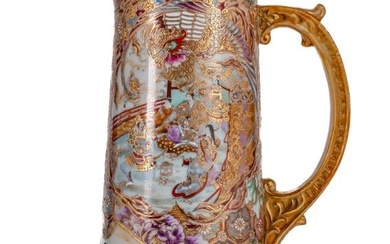Early 20th C. Japanese Scroll Painting by Hakuyo Kurata
Hakuyo Kurata (also Hakukyo Kurata, Japanese, 1881-1938). Scroll painting, early Showa period, ca. 1920s to 1930s. An elegant painting mounted on silk which is in turn mounted on paper as a scroll. The composition features three cormorants perched upon rocks in a river. Each bird presents an elegant form comprised of a lengthy beak, an ovoid body, and carefully delineated feathers while white, seafoam green, and cerulean blue sprays of water rise from the cascading river as it flows along the jagged cliffs. The artist's signature and chop are on the lower right. A stunning painting delineated in a pleasing palette of blue, green, grey, taupe, black, white, and cream hues - with tone-on-tone gold floral border, all set upon a tone-on-tone silk backing of peachy champagne hues. Size of scroll: 76.25" L x 23.125" W (193.7 cm x 58.7 cm) Size of painting: 48" L x 16" W (121.9 cm x 40.6 cm)
According to the Museum of Modern Art, Saitama "Hakuyo's real name was Shigeyoshi. Following in the footsteps of his elder brother, Teijiro, who died young, Hakuyo studied under Chu Asai. He graduated from Tokyo School of Fine Arts in 1901 and became a member of Taiheiyogakai the following year. In 1907, he took part in the art magazine Hosun. After breaking away the yoga (Western-style painting) section from the Saiko Inten (Reorganized Japan Art Institute Exhibition), in 1922, he founded Shunyokai. That year, he moved to Ueda in Nagano. He painted rural views in scrupulously realistic expressions based on sketching. In support of Nihon Nomin Bijutsu Kenkyujo (The Japan Peasant Art Institute) founded by his close friend, Kanae Yamamoto, in 1922, Hakukyo Kurata moved to Ueda as deputy manager and educational chief of the institute. He remained there until he died in 1938 and continued to pursue a strict art scrutinizing nature in a 'vivid and true-to-life attitude,' which was his aim."
Provenance: private Evergreen, Colorado, collection, USA; ex-private Denver, Colorado, USA, collection; acquired 1960 to 2000
All items legal to buy/sell under U.S. Statute covering cultural patrimony Code 2600, CHAPTER 14, and are guaranteed to be as described or your money back.
A Certificate of Authenticity will accompany all winning bids.
We ship worldwide to most countries and handle all shipping in-house for your convenience.
#163063
Condition Report: Border shows areas of creasing, tears, and a few repairs. Painting shows some creases and scuffs with a couple of areas of minute pigment loss but the imagery is still vivid. One dowel is a bit separated and appears to have been reattached at one point.
View it on
Estimate
Time, Location
Auction House
Hakuyo Kurata (also Hakukyo Kurata, Japanese, 1881-1938). Scroll painting, early Showa period, ca. 1920s to 1930s. An elegant painting mounted on silk which is in turn mounted on paper as a scroll. The composition features three cormorants perched upon rocks in a river. Each bird presents an elegant form comprised of a lengthy beak, an ovoid body, and carefully delineated feathers while white, seafoam green, and cerulean blue sprays of water rise from the cascading river as it flows along the jagged cliffs. The artist's signature and chop are on the lower right. A stunning painting delineated in a pleasing palette of blue, green, grey, taupe, black, white, and cream hues - with tone-on-tone gold floral border, all set upon a tone-on-tone silk backing of peachy champagne hues. Size of scroll: 76.25" L x 23.125" W (193.7 cm x 58.7 cm) Size of painting: 48" L x 16" W (121.9 cm x 40.6 cm)
According to the Museum of Modern Art, Saitama "Hakuyo's real name was Shigeyoshi. Following in the footsteps of his elder brother, Teijiro, who died young, Hakuyo studied under Chu Asai. He graduated from Tokyo School of Fine Arts in 1901 and became a member of Taiheiyogakai the following year. In 1907, he took part in the art magazine Hosun. After breaking away the yoga (Western-style painting) section from the Saiko Inten (Reorganized Japan Art Institute Exhibition), in 1922, he founded Shunyokai. That year, he moved to Ueda in Nagano. He painted rural views in scrupulously realistic expressions based on sketching. In support of Nihon Nomin Bijutsu Kenkyujo (The Japan Peasant Art Institute) founded by his close friend, Kanae Yamamoto, in 1922, Hakukyo Kurata moved to Ueda as deputy manager and educational chief of the institute. He remained there until he died in 1938 and continued to pursue a strict art scrutinizing nature in a 'vivid and true-to-life attitude,' which was his aim."
Provenance: private Evergreen, Colorado, collection, USA; ex-private Denver, Colorado, USA, collection; acquired 1960 to 2000
All items legal to buy/sell under U.S. Statute covering cultural patrimony Code 2600, CHAPTER 14, and are guaranteed to be as described or your money back.
A Certificate of Authenticity will accompany all winning bids.
We ship worldwide to most countries and handle all shipping in-house for your convenience.
#163063
Condition Report: Border shows areas of creasing, tears, and a few repairs. Painting shows some creases and scuffs with a couple of areas of minute pigment loss but the imagery is still vivid. One dowel is a bit separated and appears to have been reattached at one point.







